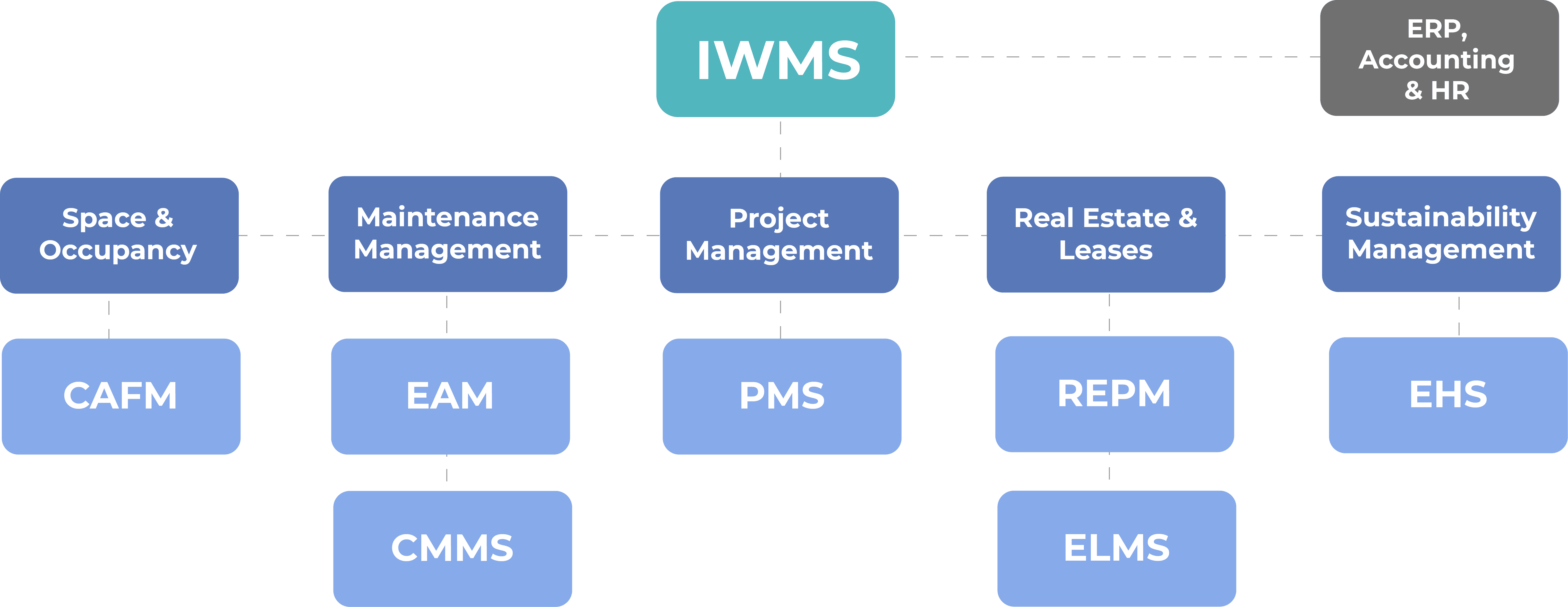Want to see your potential space management savings? Try our free Space Management Calculator.
Simply stated, Space Management involves the management of a company’s physical space inventory.
Whether you realize it or not, every organization manages their space one way or another. You might have an automated space management solution, use AutoCAD and Excel spreadsheets or manage your space with printed off floor plans and colored pencils.
At a high level, the management of your space inventory includes tracking and maintaining your space and occupancy information—identifying who sits where, understanding how much space your organization has, and how it’s actually being used, and projecting and forecasting how much real estate you will need in the future.
Every organization has their own process in place to manage their facility and real estate portfolio—it may be working for them or they might need a solution in place that aligns with the goals and objectives of the organization.
Importance of Space Management
Why is space management crucial? Consider this: empty desks in an office, crowded classrooms, and misplaced storage can all cause inefficiencies and waste resources.
Effective space management prevents these issues, creating a balance between functionality, comfort, and cost. It helps organizations adjust to changing needs, such as remote work trends or growing teams. This ensures their spaces stay flexible and useful.
Core Principles of Space Management
Maximizing Space Utilization
At its heart, space management is about ensuring that every inch of a space is used effectively. This doesn’t mean packing people into small spaces. Instead, it means designing the layout to meet real needs. This could be a shared open area or private meeting rooms.
Planning and Organization
Good space management requires strategic planning. You must map out everything from seating arrangements to storage solutions in a way that promotes efficiency. Imagine a well-oiled machine where every part has a role—this is what planning achieves.
Flexibility and Adaptability
The world is constantly changing, and so are space needs. Flexibility is important.
This includes moving office desks for hybrid work. It also means turning unused conference rooms into coworking spaces. Space management embraces change to stay relevant and efficient.
Components of Space Management
Space Planning
This involves designing the layout and functionality of a space to meet specific needs. For example, in an office, this could mean arranging desks, common areas, and meeting rooms to foster collaboration.
Space Monitoring
Once a space is set up, it’s vital to monitor how it’s being used. Are certain areas underutilized? Are meeting rooms frequently double-booked? Space monitoring provides real-time insights to address these issues.
Allocation and Usage Analytics
Data plays a big role in space management. By analyzing patterns and trends, organizations can make informed decisions about reallocating or redesigning spaces. It’s vital for space management system to have robust reporting in order to analyze space utilization data.
Why Is Space Management Important for Organizations?
This is something I hear all the time and the answer is simple, organizations need an office space management solution in order to automate their facilities processes. You might think your current process works just fine, and it might, but research has found that moving from a manual process of managing of your space inventory to an automated solution can reduce your overall operating costs, increase the productivity of your entire organization and provide you with real-time visibility into how your space is truly being used, across one or many locations. The best part is, at the end of the day you will still have time for other tasks at hand.
We have seen a lot of companies who thought they were managing their facility space just fine by using CAD drawings and Excel spreadsheets, walking the floor with a pen and pencil to track who sat where, and spending hours putting together critical reports for upper management. Companies who have moved towards an automated space management solution quickly realize they were managing their facilities inefficiently and can immediately begin seeing the results that an space solution can bring to their organization.
Benefits of Effective Space Management
Cost Efficiency and Savings
One of the primary advantages of effective space management is reducing costs. Unused or poorly utilized areas can lead to significant financial drains, from unnecessary rent payments to wasted utilities. By looking at how space is used, organizations can make changes. They can reduce waste, combine operations, or move to a better location.
Enhanced Productivity
A well-managed space is designed with the needs of its users in mind. In office environments, this could mean creating collaborative zones for team projects or quiet areas for focused work. In schools, optimized classroom layouts can improve learning outcomes. By catering to user needs, space management helps foster environments where people can thrive.
Improved Employee and Customer Experience
From employees who easily find desks in hot-desking setups to customers navigating a retail store effortlessly, effective space management prioritizes user satisfaction. Happy employees work better, and satisfied customers are more likely to come back. Both of these help a business succeed.
Sustainability and Environmental Benefits
With sustainability becoming a global priority, efficient space management supports eco-friendly goals. Reducing wasted space and energy usage helps lower an organization’s carbon footprint. Simple measures like better natural light utilization or energy-efficient layouts contribute to environmental responsibility.
Tools and Technologies Used in Space Management
Space Management Software
Modern space management relies heavily on software solutions. These tools offer dashboards to show how space is used.
They provide real-time data to help with decision-making. They also include analytics to plan future layouts. Platforms like Archibus, FM:Systems, and iOffice are leading examples.
What is CAFM vs. IWMS?
There are two big acronyms that you will hear when talking about space management solutions—Computer Aided Facility Management (CAFM) solutions and Integrated Workplace Management System (IWMS) platforms. Well, what are these and what is the difference between the two?
CAFM (Computer-Aided Facility Management)
CAFM evolved in the late 1980s with the purpose of leveraging the PC to automate the collection and maintenance of facility management information. CAFM provided facility managers with the solutions they needed to track and report on their facility and real estate information.
IWMS (Integrated Workplace Management System)
Very similar to CAFM, an IWMS is an enterprise solution that supports the planning, design and management of an organization’s physical real estate. An IWMS allows organizations to optimize the use and administration of workplace resources and communicates that information throughout the entire organization.
These still sound very similar, what is the difference?
The main difference between CAFM and an IWMS is that an IWMS allows key information to be shared between everyone in the organization whereas CAFM is limited by its inability to distribute information to those beyond facility management.
I’ve included a diagram below will help show you what solutions fall under an IWMS platform:
Integrated Workplace Management System (IWMS)

I’ll throw in one more acronym to give you the full picture of all the solutions that tie into the management of an organizations facility and real estate space: Computerized Maintenance Management Systems (CMMS).
What Is CMMS?
A CMMS is a database of information about an organizations maintenance operations. This typically includes the management of work orders and service requests, preventative maintenance scheduling and workflows, asset management and inventory control. As you can see from the IWMS diagram above, a CMMS is just a portion of the full blown IWMS suite.
IoT and Smart Devices
Internet of Things (IoT) devices, like occupancy sensors and smart lighting systems, are important for collecting real-time data. For example, sensors can tell when a meeting room is empty. They can then adjust the lighting or air conditioning to save energy.
Data Analytics and Reporting Tools
Analytics tools help managers dive deeper into usage patterns. By examining metrics like foot traffic or desk occupancy rates, organizations can identify inefficiencies and implement corrective actions.
Challenges in Space Management
Balancing Cost and Efficiency
While space management aims to optimize costs, the initial investment in tools, software, or redesigns can be high. Organizations must balance short-term expenses with long-term savings to justify their spending.
Adapting to Changing Needs
The needs of an organization can change rapidly. After the COVID-19 pandemic, many companies had to rethink their office layouts. This was due to the shift to hybrid work models. Adapting to such changes requires flexibility and forward-thinking strategies.
Overcoming Implementation Barriers
Adopting new systems or processes can face resistance from employees. Ensuring a smooth transition involves training, communication, and demonstrating the benefits of space management.
Space Management in Different Industries
Corporate Sector
Corporations rely on space management to create functional office environments that align with business goals. Features like hot-desking, collaborative areas, and private workspaces cater to diverse employee needs.
Education and Training Institutions
Schools, colleges, and universities manage spaces like classrooms, labs, and sports facilities to maximize learning outcomes. Proper scheduling and efficient use of resources enhance both student and teacher experiences.
Healthcare and Public Facilities
In healthcare, managing spaces like patient rooms, operating theaters, and waiting areas ensures smooth operations and better care. Properly planned layouts can even reduce stress for patients and staff.
Trends Shaping Space Management
Hybrid Work Environments
As businesses embrace flexible working models, space management has shifted to accommodate hybrid setups. Shared desks, virtual collaboration tools, and flexible seating arrangements are now standard considerations.
Sustainability and Green Buildings
Organizations are increasingly adopting eco-friendly space management practices. Sustainable designs, energy-efficient layouts, and minimizing space wastage align with both ethical and economic goals.
Technological Integration
The integration of AI, IoT, and augmented reality is revolutionizing space management. AI can predict future space needs, while augmented reality can help visualize layouts before implementation.
Space Management Strategies
Conducting Space Audits
Regular space audits are crucial for understanding how spaces are being used. This process involves collecting data on occupancy, foot traffic, and resource usage to identify underperforming areas.
Collaborative Space Design
Engaging employees and stakeholders in the design process ensures the space meets their needs. Collaborative planning fosters a sense of ownership and leads to better outcomes.
Regularly Updating Space Allocations
Space needs can evolve over time. Regularly revisiting and updating allocations ensures that layouts remain relevant and efficient.
Measuring the Success of Space Management
Key Performance Indicators (KPIs)
KPIs like space utilization rates, occupancy levels, and energy efficiency are critical metrics for evaluating the success of space management initiatives.
Space Utilization Rates
Tracking how much space is actually being used helps identify opportunities for improvement. High utilization rates indicate efficiency, while low rates suggest areas that need adjustment.
Employee and Stakeholder Feedback
Feedback from those using the spaces provides qualitative insights that data alone might miss. An invaluable tool for refining layouts and strategies exists.
Future of Space Management
Emerging Technologies
As technology changes, space management will use new tools. These tools include AI for forecasting. Designers will use virtual reality for design. Advanced IoT devices will help with monitoring.
Evolving Workplace Dynamics
The rise of remote work, hybrid setups, and agile office designs will shape the future of space management. Adaptability and innovation will be key to staying ahead of these changes.
Conclusion
Space management is an important practice for organizations. It helps them improve their physical spaces, cut costs, and boost user experiences.
By using strategic planning, embracing technology, and staying flexible, businesses can create spaces that meet their current needs. These spaces will also be ready for future challenges. Whether it’s an office, school, hospital, or store, good space management changes places into efficient areas. This helps drive success.
FAQs
1. What is the primary goal of space management?
The main goal is to make better use of physical spaces. This will help improve efficiency, lower costs, and increase user satisfaction.
2. How does technology support space management?
Technologies such as space management software, IoT devices, and analytics tools give real-time data and insights. This helps improve decision-making.
3. Is space management relevant for small businesses?
Yes, even small businesses benefit from space management by saving costs and creating a more productive environment.
4. What industries use space management the most?
Industries like corporate offices, healthcare, education, and retail heavily rely on space management for operational efficiency.
5. How often should space audits be conducted?
Experts recommend performing space audits annually or whenever significant changes occur in organizational needs.
Want to see your potential space management savings? Try our free Space Management Calculator.










